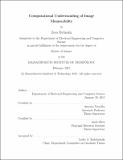| dc.contributor.advisor | Antonio Torralba and Aude Oliva. | en_US |
| dc.contributor.author | Bylinskii, Zoya | en_US |
| dc.contributor.other | Massachusetts Institute of Technology. Department of Electrical Engineering and Computer Science. | en_US |
| dc.date.accessioned | 2015-06-10T18:40:15Z | |
| dc.date.available | 2015-06-10T18:40:15Z | |
| dc.date.copyright | 2015 | en_US |
| dc.date.issued | 2015 | en_US |
| dc.identifier.uri | http://hdl.handle.net/1721.1/97256 | |
| dc.description | Thesis: S.M., Massachusetts Institute of Technology, Department of Electrical Engineering and Computer Science, 2015. | en_US |
| dc.description | This electronic version was submitted by the student author. The certified thesis is available in the Institute Archives and Special Collections. | en_US |
| dc.description | Cataloged from student-submitted PDF version of thesis. | en_US |
| dc.description | Includes bibliographical references (pages 77-82). | en_US |
| dc.description.abstract | Previous studies have identified that images carry the attribute of memorability, a predictive value of whether a novel image will be later remembered or forgotten. In this thesis we investigate the interplay between intrinsic and extrinsic factors that affect image memorability. First, we find that intrinsic differences in memorability exist at a finer-grained scale than previously documented. Moreover, we demonstrate high consistency across participant populations and experiments. We show how these findings generalize to an applied visual modality - information visualizations. We separately find that intrinsic differences are already present shortly after encoding and remain apparent over time. Second, we consider two extrinsic factors: image context and observer behavior. We measure the effects of image context (the set of images from which the experimental sequence is sampled) on memorability. Building on prior findings that images that are distinct with respect to their context are better remembered, we propose an information-theoretic model of image distinctiveness. Our model can predict how changes in context change the memorability of natural images using automatically computed image features. Our results are presented on a large dataset of indoor and outdoor scene categories. We also measure the effects of observer behavior on memorability, on a trial-bytrial basis. Specifically, our proposed computational model can use an observer's eye movements on an image to predict whether or not the image will be later remembered. Apart from eye movements, we also show how 2 additional physiological measurements - pupil dilations and blink rates - can be predictive of image memorability, without the need for overt responses. Together, by considering both intrinsic and extrinsic effects on memorability, we arrive at a more complete model of image memorability than previously available. | en_US |
| dc.description.statementofresponsibility | by Zoya Bylinskii. | en_US |
| dc.format.extent | 82 pages | en_US |
| dc.language.iso | eng | en_US |
| dc.publisher | Massachusetts Institute of Technology | en_US |
| dc.rights | M.I.T. theses are protected by copyright. They may be viewed from this source for any purpose, but reproduction or distribution in any format is prohibited without written permission. See provided URL for inquiries about permission. | en_US |
| dc.rights.uri | http://dspace.mit.edu/handle/1721.1/7582 | en_US |
| dc.subject | Electrical Engineering and Computer Science. | en_US |
| dc.title | Computational understanding of image memorability | en_US |
| dc.type | Thesis | en_US |
| dc.description.degree | S.M. | en_US |
| dc.contributor.department | Massachusetts Institute of Technology. Department of Electrical Engineering and Computer Science | |
| dc.identifier.oclc | 910342463 | en_US |
